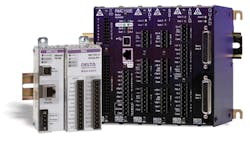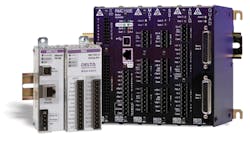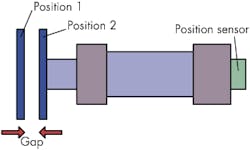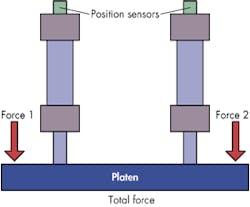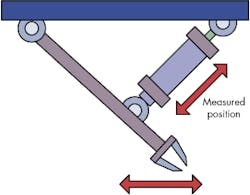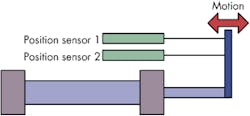Options Add Functionality to Motion Controllers
The traditional closed-loop electro-hydraulic control system uses a motion controller that drives an actuator via a proportional servovalve, based on an input from a feedback sensor, for example, the position of a cylinder’s piston rod. Although maintaining a one-to-one relationship between sensor and actuator is fine for many applications, limitations to this traditional approach can negatively impact the productivity, reliability and operational cost of other types of machines.
To remove these limitations, new capabilities are being added to motion controllers that add flexibility in the number and type of feedback devices that can be used, with the ability to perform pre-processing of feedback data before it is used by the control loop. These advances bring new dimensions of precision and reliability to motion systems, and can be grouped under the general term “custom feedback” (Fig. 1).
Custom Feedback Does The Math
Some applications can benefit from mathematical calculations performed on the raw inputs from multiple sensors. Consider, for example, a paper pulp refiner that must precisely control the plate gap through which pulp passes as part of the thermo-mechanical refining process. This can be complicated because the stationary plate can move slightly with changes in temperature and other factors. Because the gap is the difference between the two plate positions, Fig. 2, it is easier for the motion controller to control the difference in plate positions with the control loop, rather than controlling the position of one plate but needing to adjust for position changes of the other plate. With the ability to compute a custom feedback value, controlling to this difference is straightforward.
Another example of mathematical pre-processing of sensor inputs simplifies the control of a multi-cylinder press (Fig. 3). The cylinder forces are measured individually (via load cells or by measuring the differential pressure across the pistons), but the press must control the sum of the forces from all the cylinders. Controlling the total force imparted to the work piece is an important feature for electronic level control of the platen, since each cylinder position is also controlled. Precise level control can even eliminate the need for heavy metal guides to keep the platen level.
Another useful calculation is averaging the data from multiple identical sensors, for example in presses that require extremely accurate force. If the required accuracy is higher than the load cell specifications, then multiple load cells can be averaged. The small differences in load readings between the cells, which can occur at different times and under different environmental conditions, are averaged out. A side benefit of the averaging process is that noise signals on individual load cell outputs would also be reduced by the averaging process.
Besides the sum and difference and averaging of feedback inputs, more sophisticated mathematical functions can be applied to raw sensor data. A mathematical calculation can “linearize” the feedback from a transducer that may respond to stimulus in a non-linear fashion — to straighten the output of a transducer to make up for a nonlinear response, or to calculate the position of some point that is geometrically related to the transducer measurement. For example, controlling the horizontal position of the end effector attached to a swing arm in a robotic material handler, Fig. 4, may involve working with raw position feedback that is available from the cylinder only. The position of the end effector can be calculated by applying a trigonometric equation to the cylinder position using custom feedback processing.
Switching Overcomes Sensor Problems
Logical functions can also be applied to enable switching between feedback sources. This capability is critical for constructing highly reliable fail-safe systems. Consider the value of connecting a control loop to multiple identical sensors, so that if one of the feedback devices fails, the system can continue operating without interruption.
This fail-safe configuration is helpful in applications such as stamping machines that exhibit severe vibration and noise. Sensor failures can happen without warning, resulting at best in a period of downtime while the sensor is replaced. At worst, a sensor can fail without being noticed and cause damage or affect product quality before the problem is detected. Usually, the motion controller electronics can be segregated to the safety of a remote panel, but the sensor itself typically needs to be located right where the action happens — on a press ram, for example. With feedback-switching, when the controller detects that one sensor is going bad, it seamlessly switches to another sensor, even in the middle of a motion operation.
Feedback switching is also useful in testing applications that employ multiple transducers in order to provide the desired resolution over a range of measurement that is wider than the range of any single transducers, or in order to provide a higher degree of measurement sensitivity over a small range with the ability to make measurements over a much broader range at a lower sensitivity.
An example of the latter is an assembly strength testing machine. Designers of equipment such as this often struggle with meeting the diametrically-opposed requirements of a large measurement range and high accuracy. Achieving high accuracy is relatively simple for a small measurement range, but not so for a large range. If sensors with sufficiently high accuracy over a wide range even exist, they will be very expensive.
If multiple pressure sensors of different sensitivity ranges are installed, however, the accuracy of each sensor needs only account for one range, not the entire range (Fig. 5). If we allow for lesser accuracy (in absolute terms) in the larger pressure ranges and higher accuracy in the smaller ranges, then the required sensor accuracy, and hence the overall sensor cost, is greatly reduced.
Another application that benefits from feedback switching is a deep-draw metal forming press, where it is possible to increase resolution over a critical range by having the motion controller do pre-processing to selectively combine inputs from a short-stroke, high-resolution feedback device with a long-stroke, coarse-resolution device, so they look like one feedback device to the control loop. This is a much more economical solution to the need for precise measurements over a certain range compared to the cost of using a sensor that responds with high-precision results over the entire range of operation.
Handling Custom Feedback
Two motion controllers with custom feedback processing capability are the RMC75 two-axis controller and RMC150 eight-axis controller manufactured by Delta Computer Systems Inc. (Fig. 1, again). When programming these controllers, axes defined with custom feedback do not have an assigned physical feedback (i.e., direct connection to I/O). Rather, they use the contents of internal registers as feedback variables. The machine designer creates a user program that continuously calculates the feedback value and assigns it to the appropriate register, whose contents are in turn used by the motion controller’s control loop. The ability to employ user programs gives users the flexibility to perform any logic functions and calculations necessary for precise closed-loop control.
User programs carry out complex sequences of commands on the Delta RMC controller without requiring intervention from a PLC or other controller. This allows the controller to respond to events within its control-loop time, which can be as short as one millisecond, rather than the scan rate of a PLC, which can be more than ten times longer, imparting latency delays and limiting the speed of the process that can be controlled. Incorporating the feedback processing function into the motion controller also reduces the amount of PLC programming required. The number of user programs supported by Delta’s controllers is only limited by the memory capacity of the controller.
With these design hints in mind, designers of systems limited by the constraint of the 1:1 relationship between sensors and motion axes should seek out a motion control solution that supports custom feedback capability, which gives the flexibility to use feedback from a source or sources other than directly from a hardware input.
About the Author

Leaders relevant to this article:
